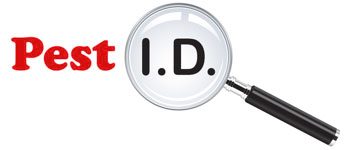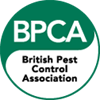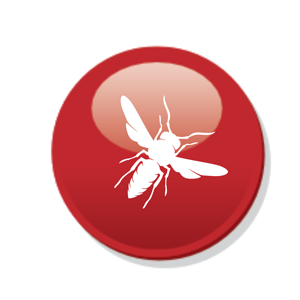
Wasp Nest Removal Services
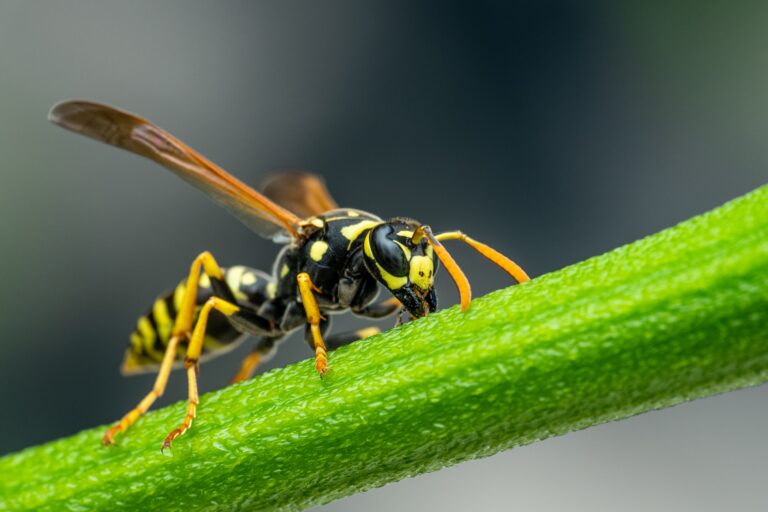
Wasp Nest Removal Services for Essex & East London
A familiar sight in the summer time is the dreaded common wasp, a widely hated insect that ruins al fresco dining and causes a nuisance in beer gardens. Although the wasp is an important pollinator and provides its very own pest control service for gardeners, its preference for building nests in roofs and other house cavities makes it a common pest in the UK, and a very unwanted house guest.
A wasp problem in the home can not only be inconvenient, but also it is potentially very dangerous. Our team of professional wasp exterminators understand the need for fast and safe wasp removal, and offer wasp pest control services in Essex & East London, including areas in and around Chelmsford, Southend and Basildon.
Wasps start building their nests when the weather warms up in the early spring and summer time. A queen will find the location for the nest, and build a nest for herself to hatch a number of workers. These workers will then continue to build up the nest, which by the end of the summer can contain somewhere in the region of 10,000 wasps. The earlier a wasps nest is noticed, the easier the removal is as the nest will be much smaller and less populated. Removal of wasp nests can be hazardous, so let our team of professional exterminators and pest control experts safely and thoroughly remove these pests.
Call now on 0800 955 0003
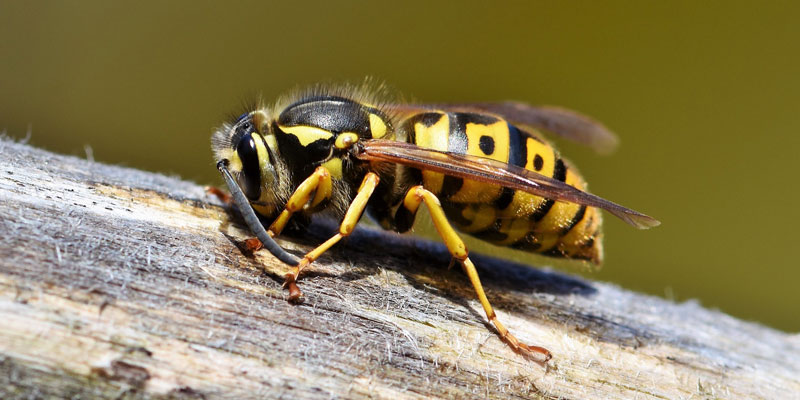
How do I know if I have a wasp problem?
There are several signs that point to wasps making their home within yours. It’s important to flag a problem quickly, so that the removal is easier and so there are less wasps around your home.
- Seeing wasps in or around your property – either swarming in a single area or appearing in rooms in your house. You may not notice them, and instead only be made aware of their presence by their loud buzzing.
- Noticing evidence of chewed materials – wasps build their nests by using chewed paper or wood, so any signs of holes or chewing could indicate their presence.
- A clear flight path to and from a small hole in your property or a hole in the ground is one of the best indicators of a nest. You would usually see several wasps a minute coming and going.
- Noticing a wasps nest – wasps are clever enough to hide their nests in walls or hidden areas in lofts. But if you catch sight of wasps coming and going from your property, you may be able to track them back to their nest. Towards the end of summer is when the nests are at their largest so may be easiest to spot at that time of year.
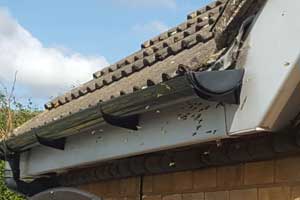
Signs of a wasps nest
Wasps will often make nests in shielded areas of your home. On hotter days and later in the summer you may see a steady stream of wasps coming and going through one small gap.
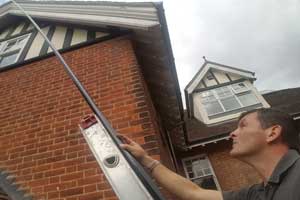
Safety comes first
Using an 8 metre extendable lance, most wasp nests can be treated at ground level and at a safe distance from the attack zone.
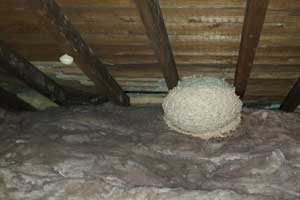
Wasp nest destruction
Usually from the outside, specialist wasp insecticide is injected at high pressure into the heart of the nest. By the morning the nest will be totally inactive.
What causes a wasp problem?
Wasps like to build their nests anywhere that has a sturdy, horizontal base to hang from, preferring a corner where the nest will be protected – so if your property has things like eaves, ceilings and overhangs, these are ideal places for them. Wasps will also excavate holes in the ground to produce very large underground nests.
Wasps will look for a building material nearby so that they can easily build their nests. If you have a good supply of materials like wood fibre, this can be chewed by the queen to make a paper pulp to build with.
While adult wasps only eat sugars, they kill and feed insects to their young. A good supply of insect prey nearby makes a great nesting location, so a home or garden full of bugs is very likely to attract wasps.
The new queens needs access to indoor shelter during the winter months, as the previous nest will decompose and be abandoned by the hive. If your property provides a safe place for the queen to survive during the colder months then during the spring she will rebuild a new nest in her new location.
What types of wasps are there?
- Britain has two main species of wasps: the common wasp (Vespula vulgaris) and the German wasp (Vespula germanica). These species are very similar in size and colour – predominantly yellow with black markings.
- You may also see the red wasp (Vespula rufa) and the tree wasp (Dolichovespula sylvestris).
- The Saxon wasp (Dolichovespula saxonica) has been in the UK since the 1980’s and is mainly found in the south.
Where can wasps be found in the home?
Wasps aren’t too fussy about where they build their nests, they will look for a space that is dry, safe and has something that will provide a good structure for them to build from. The first places that our Pest ID wasp pest control experts would check for a nest are roof spaces, lofts, wall cavities and air bricks. Outside the home, wasps will make themselves at home in garages and other outbuildings like sheds. Our experts will also check gardens for nests in trees, hedges as well as holes in the ground.
Do I have a swarm or a nest?
If you notice wasps swarming around fence posts, ivy or willow trees then they are either having a feeding frenzy or building a nest. Unfortunately we are unable to treat a swarm of wasps that are ‘hanging around’ like this as we need to be able to treat the nest itself.
Likewise, we often get called out to a mass of “wasps” all clumped together between May and July, these will actually be honey bees waiting to find a new suitable nest site. They usually move on after a few hours, or sometimes days.
What issues can a wasp pest control issue cause?
As we all know, the biggest problem with wasps is that they sting! Most people will experience pain, swelling, redness and some discomfort after a sting, but for others a sting can be very dangerous. An allergy to a wasp sting may cause may develop life threatening allergic reactions, called ‘anaphylaxis’, where breathing and circulation are affected. Even without an allergy, your breathing may still be affected if you are stung on the face or neck, as swelling to your tongue or throat could lead to your airways becoming blocked. There is a higher risk to children and pets who can be more sensitive to insect bites and stings.
Wasps nests often need quick removal due to their size – they can be very large and can grow to 60cm or more in diameter – but they are rarely damaging to the roofs, sheds and lofts that they are built on when they are removed safely and quickly by professionals. However, the materials used to make the nests tend to cause more destruction – if removal is delayed it can result in wood damage. Or if the nest is created near plasterboard, the worker wasps have been known to use plaster board as part of their nest building material and sometimes even break through the plasterboard into the house.
Ground wasp nests tend to be more aggressive as they are usually more vulnerable to predators. Lawn mowers used near their nests can easily set them off into a stinging frenzy.
Can I get rid of a wasp problem myself?
You should never attempt to move an active wasp nest yourself. Each wasp’s nest colony has its own personality, with some being far more aggressive than others. If a nest feels threatened in any way, sentries will set-off an ‘attack’ pheromone. This is a chemical released into the air that commands all wasps to attack anything nearby that could be a threat. When an attack pheromone has been released, wasps have been known to chase their victims for some distance.
The team of professional pest controllers at Pest ID have the right equipment and training to be able to do the job safely. PPE is essential to avoid painful stings as wasps will attack when their nest is threatened. Wasp nests are also usually found in hard to access places, and professionals are more likely to be able to safely reach these spots and have the right equipment to help them.
Just imagine how dangerous is could be if you’re on a ladder when an attack pheromone is released and the wasps start a stinging frenzy!
It can be easy to confuse a bees nest and a wasp nest if all you can identify is the buzzing of yellow and black insects. Bees and wasps require a different approach to nest removal, and a professional pest control expert will be able to correctly identify the insect and know the appropriate removal technique.
Why choose Pest ID for wasp nest removal?
The team at Pest ID will identify where the nest is, the threat levels of the colony, and work out what is the safest way to destroy the nest. Unfortunately, there is no way of relocating a wasps nest.
In most cases, we inject a specialist wasp powder at high pressure which infiltrates the main arteries within the nest. As wasps continue to enter the nest for a few hours after, their wings fan the powder deeper into the heart of the nest. Once treated, the nest will be completely destroyed within 24 hours after application of our licenced wasp insecticide.
Despite most pest control companies referring to the term ‘wasps nest removal’, it is rare to actually take the nest away. Once destroyed, a nest is never used again and will disintegrate in time. Actual nest removal can be carried out, usually at an extra cost, if the nest can be reached safely. However, in the winter months, this lightweight paper structure can be removed by anyone who can safely reach it.
We are full BPCA members and we are also CEPA Certified, allowing you the peace of mind to know that your pest control problem is in safe and trusted hands. Pest ID are small enough to care, but large enough to matter – and we pride ourselves on our client satisfaction, with high numbers of client referral and repeat business.
Is there any aftercare required?
No aftercare is required, but you will need to keep away from the nest for around 24 hours after treatment as the remaining wasps may still feel threatened and sting. The old nests will never get used again and eventually disintegrate and do no further harm.
Do Pest ID offer wasp nest removal in commercial properties?
We offer wasp nest removal services for both residential and commercial properties. We understand the inconvenience a wasp nest can cause – and the impact this can have in a commercial setting.
If a wasp nest takes over an area of your property it will render that area unsafe for use. In a residential property this can be a nuisance but in a commercial property having areas that are unsafe to access can cause a loss in profit (e.g kitchen or garden in a pub out of use for a period of time). A nearby wasp nest can be a real nuisance to outdoor diners, drinkers or children eating/drinking sweet things.
We understand the sensitive nature of having a pest control problem, and we can park away from your property if required. Whilst being known as Pest ID, our technicians uniforms have ID Group logos, so can offer you the utmost of discretion.
Why choose Pest ID for your wasp nest removal services?
Pest ID are considered unique as despite being a small family firm with just six technicians, we have the accreditations and skill sets that are usually only available from the big pest control firms that lack the personal touch.
Check out our google and Checkatrade reviews too, we believe we are the most friendly and helpful firm in the area.
What can I do to stop my wasp problem from recurring?
Make sure that you stop wasps from entering your property by sealing any cracks in door and window seals, filling any holes in brickwork, and checking that there are no potential entry points for the insects. Fly screens can be used on doors and windows to prevent easy entrance.
Wasps are famously attracted to sugary drinks, as well as meats and other juices. So make sure that rubbish is covered so there are no food sources available, and keep kitchen bins away from doors and windows.
Another good food source for wasps are insects, so keeping your garden (and home!) as bug free as possible will remove their food source and deter wasps from hanging around. If you have fruit trees in your garden then make sure that fallen fruit is cleaned away. This is particularly important in late summer when wasps are after sweet food. They also need a water source, so limit or remove standing water sources. Planting herbs with aromatic scents, like mint, thyme and eucalyptus, can help to repel wasps.
Wasp traps or wasp pots are available to buy, or you can make one using water and a sugar solution.
Be aware of nests in early spring time as they will be around a golf ball in size and are easier to treat at that stage. At the end of summer avoid sweet smells – wasps are particularly attracted to sweet smelling perfumes at this time of year.
